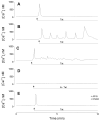Excitatory effects of human immunodeficiency virus 1 Tat on cultured rat cerebral cortical neurons
- PMID: 18164555
- PMCID: PMC2277335
- DOI: 10.1016/j.neuroscience.2007.11.031
Excitatory effects of human immunodeficiency virus 1 Tat on cultured rat cerebral cortical neurons
Abstract
Human immunodeficiency virus 1 (HIV-1) Tat protein is one of the neurotoxins involved in the pathogenesis of HIV-1-associated neuronal disorders. Combined electrophysiological and optical imaging experiments were undertaken to investigate whether HIV-1 Tat30-86, herein referred to as Tat30-86, acted directly or indirectly via the release of glutamate or both and to test its effect on the properties of spontaneous quantal events in cultured cortical neurons. Whole-cell patch recordings were made from cultured rat cortical neurons in either current- or voltage-clamp mode. Tat30-86 (50-1000 nM) induced in a population of cortical neurons a long-lasting depolarization, which was accompanied by a decrease of membrane resistance and persisted in a Krebs solution containing tetrodotoxin (TTX, 0.5 microM). Depolarizations were slightly reduced by pretreatment with glutamate receptor antagonists 6-cyano-7-nitroquinoxaline-2,3-dione (CNQX) (10 microM) and d-2-amino-5-phosphonovaleric acid (AP-5) (50 microM), and were markedly reduced in a Ca(2+)-free Krebs solution; the differences were statistically significant. Tat30-86-induced inward currents had a reversal potential between -30 and 0 mV. While not causing a noticeable depolarization, lower concentrations of Tat30-86 (10 nM) increased membrane excitability, as indicated by increased numbers of neuronal discharge in response to a step depolarizing pulse. Tat30-86 (10 nM) increased the frequency of spontaneous miniature excitatory postsynaptic currents (mEPSCs), while not significantly affecting their amplitude. Tat30-86 (10 nM) moderately increased the frequency as well as the amplitude of spontaneous miniature inhibitory postsynaptic currents (mIPSCs). Ratiometric Ca(2+) imaging studies showed that Tat30-86 produced three types of Ca(2+) responses: 1) a fast and transitory increase, 2) Ca(2+) oscillations, and 3) a fast increase followed by a plateau; the glutamate receptor antagonists eliminated the late component of Ca(2+) response. The result suggests that Tat30-86 is an active fragment and that it excites cortical neurons directly and indirectly via releasing glutamate from adjacent neurons.
Figures







Similar articles
-
Glutamate hyperexcitability and seizure-like activity throughout the brain and spinal cord upon relief from chronic glutamate receptor blockade in culture.Neuroscience. 1996 Oct;74(3):653-74. doi: 10.1016/0306-4522(96)00153-4. Neuroscience. 1996. PMID: 8884763
-
Dopamine inhibition: enhancement of GABA activity and potassium channel activation in hypothalamic and arcuate nucleus neurons.J Neurophysiol. 1997 Aug;78(2):674-88. doi: 10.1152/jn.1997.78.2.674. J Neurophysiol. 1997. PMID: 9307104
-
Inhibition by opioids acting on mu-receptors of GABAergic and glutamatergic postsynaptic potentials in single rat periaqueductal gray neurones in vitro.Br J Pharmacol. 1994 Sep;113(1):303-9. doi: 10.1111/j.1476-5381.1994.tb16209.x. Br J Pharmacol. 1994. PMID: 7812626 Free PMC article.
-
Purinergic modulation of area postrema neuronal excitability in rat brain slices.Brain Res. 2007 Aug 24;1165:50-9. doi: 10.1016/j.brainres.2007.06.003. Epub 2007 Jun 15. Brain Res. 2007. PMID: 17658494
-
Regulation of synaptic input to hypothalamic presympathetic neurons by GABA(B) receptors.Neuroscience. 2006 Oct 13;142(2):595-606. doi: 10.1016/j.neuroscience.2006.06.039. Epub 2006 Aug 2. Neuroscience. 2006. PMID: 16887273
Cited by
-
G protein-coupled estrogen receptor 1-mediated effects in the rat myometrium.Am J Physiol Cell Physiol. 2011 Nov;301(5):C1262-9. doi: 10.1152/ajpcell.00501.2010. Epub 2011 Aug 24. Am J Physiol Cell Physiol. 2011. PMID: 21865584 Free PMC article.
-
Network analysis of hippocampal neurons by microelectrode array in the presence of HIV-1 Tat and cocaine.J Cell Physiol. 2018 Dec;233(12):9299-9311. doi: 10.1002/jcp.26322. Epub 2018 Jun 22. J Cell Physiol. 2018. PMID: 29206302 Free PMC article.
-
Cocaine self-administration enhances excitatory responses of pyramidal neurons in the rat medial prefrontal cortex to human immunodeficiency virus-1 Tat.Eur J Neurosci. 2015 May;41(9):1195-206. doi: 10.1111/ejn.12853. Epub 2015 Feb 24. Eur J Neurosci. 2015. PMID: 25707266 Free PMC article.
-
Effects of HIV-1 Tat on enteric neuropathogenesis.J Neurosci. 2014 Oct 22;34(43):14243-51. doi: 10.1523/JNEUROSCI.2283-14.2014. J Neurosci. 2014. PMID: 25339738 Free PMC article.
-
Synaptic dysfunction in the hippocampus accompanies learning and memory deficits in human immunodeficiency virus type-1 Tat transgenic mice.Biol Psychiatry. 2013 Mar 1;73(5):443-53. doi: 10.1016/j.biopsych.2012.09.026. Epub 2012 Dec 4. Biol Psychiatry. 2013. PMID: 23218253 Free PMC article.
References
-
- Aksenov MY, Aksenova MV, Nath A, Ray PD, Mactutus CF, Booze RM. Cocaine-mediated enhancement of Tat toxicity in rat hippocampal cell cultures: The role of oxidative stress and D1 dopamine receptor. Neurotoxic. 2006;27:217–228. - PubMed
-
- Augustine GJ, Santamaria F, Tanaka K. Local calcium signaling in neurons. Neuron. 2003;40:331–346. - PubMed
-
- Behnisch T, Francesconi W, Sanna PP. HIV secreted protein Tat prevents long-term potentiation in the hippocampal CA1 region. Brain Res. 2004;1012:187–189. - PubMed
-
- Bonavia R, Bajetto A, Barbero S, Albini A, Noonan DM, Schettini G. HIV-1 Tat causes apoptotic death and calcium homeostasis alterations in rat neurons. Biochem Biophys Res Commun. 2001;288:301–308. - PubMed
-
- Brailoiu E, Brailoiu GC, Mameli G, Dolei A, Sawaya BE, Dun NJ. Acute exposure to ethanol potentiates human immunodeficiency virus type 1 Tat-induced Ca2+ overload and neuronal death in cultured rat cortical neurons. J Neurovirol. 2006;12:17–24. - PubMed
Publication types
MeSH terms
Substances
Grants and funding
LinkOut - more resources
Full Text Sources
Miscellaneous

